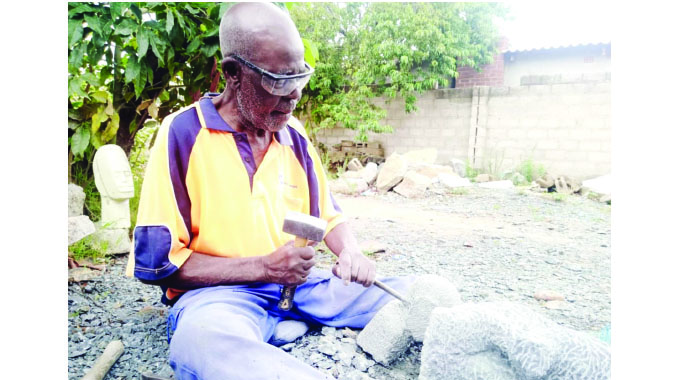Sylvester Mubayi, fare thee well

Timothy Akuda in Guildford, England
The sad news of the demise of Sylvester Mubayi came as a shock to many as much as it did to me. Two weeks ago, and a day before I left Harare for Guildford, I went to say goodbye to Sylvester Mubayi.
This was against the background of the friendship we had shared and nurtured over the past five years. He had just finished one of my sculptures and judging from the way he was working the stone, he looked healthy.
Little did I know that it would be the last time to see him and the last words to share.
Over the past five years I spent a lot of hours with him at his workshop and we built a strong relationship. He referred to me as “mwana” son.
On some days he would call me, and I would accompany him to the doctor’s visits.
I never got tired of asking him questions on the sculpture movement and surprisingly he never got tired of satisfactorily answering.
Over the years I collected over fifty sculptures by him but unfortunately to date I remain with 15. I made a promise to him that I will keep these sculptures in Zimbabwe for future generations to benefit and I am going to keep that promise.
Mubayi was no ordinary artist. He belonged to the first generation of artists.
Unfortunately, more than ninety percent of his contemporaries have now passed away. Unfortunately this year alone we lost Josiah Manzi and Edward Chiwawa leaving only two noticeable figures and that is Enos Gunja and Ephraim Chaurika.
Mubayi was born in 1942 in Chiota, an area in the southeastern part of Harare.
The proximity of his birth place to Harare made it possible for him to occasionally visit the city in search of work. During one of such visits in 1966 he met up with Tom Blomefield at The National Gallery of Zimbabwe. Mubayi showed interest at the sculptures that Blomefield was delivering at the Gallery and was invited to join the art community back in Guruve. The Community was in its infancy and Mubayi immediately became one of the founding members.
His stay in Tengenenge lasted a few years as he was lured by Frank McEwen the first director of the then National Gallery of the then Rhodesia to join the Workshop School in Harare.
Under the guidance of Frank he was put in charge of Vukutu, a “side show” established in Nyanga by Frank McEwen and his first wife.
Vukutu was set up by McEwen as he tried to have control over some of the stone artists. Unfortunately due to different factors the Vukutu project did not last much.
However Mubayi remained one of the artists that McEwen was so fond of and it became apparent in the catalogues published in the 1970s.
In 1969 he became the first Zimbabwean sculptor to receive the Ernest Oppenheimer Memorial Award. In 1971 he participated in one of the most important exhibitions to date at the Musee Rodin in Paris titled “Sculpture Contemporaine des Shona d’Afrique” which was organised by Frank McEwen.
In the late 1970s Mubayi joined the Artist in Residence, a program which was initiated by Roy Guthrie the founder and director of Chapungu Sculpture Park.
Under the program Sylvester travelled and exhibited in different parts of the world including an exhibition in London in 1981 where he attended and participated together with the late Nicholas Mukomberanwa and Joseph Ndandarika.
From 1969 to 1987 Mubayi participated in crucial exhibitions hosted by the National Gallery of Zimbabwe and in August of 2008 the gallery did a retrospective of his works with a One Man exhibition.
In 2017 through a direct invitation by the National Gallery of Zimbabwe, Sylvester Mubayi represented Zimbabwe at the Venice Biennale.
He became the first sculptor of the “old guard” to participate since Zimbabwe’s maiden appearance in 2011. His body of work touched on different aspects including war and tradition and reference here is being made to War Victim and Woman Grinding.
In 2020 the Government of Zimbabwe identified and honoured him amongst other 40 individuals deemed to have made an impact in the arts sector since Zimbabwe’s independence in 1980. Other holders of the Legends@40 title are Tapfuma Gutsa and Dominic Benhura.
Mubayi is well remembered for keeping his traditions and culture above everything else. In one of my interviews with him he told me, “I have travelled a satisfactory journey in terms of art. I have been to different countries and seen their cultures and the type of artworks they produce. I crossed the Thames River in a boat and landed at Windsor Castle. I have come to appreciate and embrace African culture even more. I am proud of it and I am privileged to represent it through my work and sculptures.”
His style has stood the test of time with no direct evidence of plagiarism. In some instances I watched and recorded him work on a piece of sculpture from start to finish without imploring the assistance of anyone.
He told me, “I have not allowed anyone to master some of my techniques especially when I work the face area and how I put the nose, the eyes, ears and the mouth. I want my art to be identified with me alone and I have managed to do that for many decades with success. Even my children have not mastered my work. They work on their different styles and I am happy about that.”
Mubayi was a prestigious sculptor who will never be replaced by anyone and whose demise will always be hard to fathom. As he will be laid to rest in his place of birth in Chiota I take time to reflect on his words, “I have crossed many physical rivers in my life but most importantly I have crossed rivers in overcoming life challenges as has done many people.’’










Comments